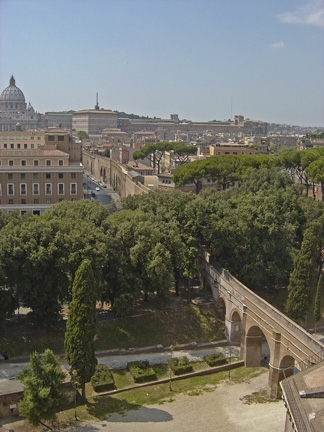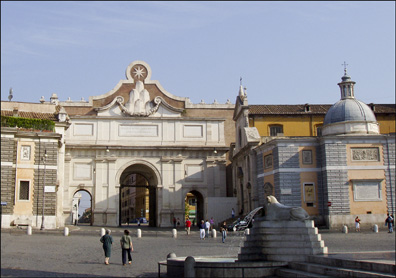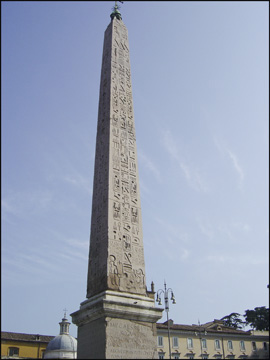
Day 6–Castle Sant’Angelo
Our virtual tour continues to follow the path of the Illuminati. We find Professor Langdon charging down narrow passageways in Castle Sant’Angelo, searching for Vittoria. The timeless structure and bridge leading to its doors have rested on the banks of the Tiber River since 139 AD.
The ancient cement exterior, a round shape surrounded by high walls, stands stark and imposing, hardly a castle in the traditional sense. Compared to an Italian villa or luxuriant St. Peter’s Basilica, Castle Sant’Angelo looks primitive and unfinished.
Originally constructed as Emperor Hadrian ‘s tomb, the mausoleum’s intended function changed almost as often as the popes. Over two millennia the site served as a fortress, prison, papal refuge and palace, military barracks, museum and …in Angels & Demons–the Church of Illumination and secret lair of the evil Hassassin.

When the plague struck Rome in 590 AD, Pope Gregory the Great is said to have seen an apparition of an angel, Michael, sheathing his sword above the castle. He believed this meant the end of the disease for his city. In remembrance, a statue of Archangel St. Michael was erected high up on the terrace and the name Hadrian’s Tomb was changed to “Castle of the Holy Angel- Castle Sant’Angelo.”

In 1277 Pope Nicholas II ordered the building of massive circular walls and the famous 2,000 foot-long corridor connecting to the Vatican. The first floor includes a winding ramp about 400 feet long. Between the 10th and 14th centuries this defensive stronghold remained the only fortress in Rome. Powerful families fought to control it.
Many rooms within the fortress were turned into small cells for political prisoners, some more like torture chambers. The courtyards were used for executions by decapitation and the heads of the condemned then hung along the bridge.
The popes demanded ownership of the castle as one of the conditions for their return from Avignon. They left France for Rome and regained the strategic property, which they hold to this day.
During the Renaissance, Popes Nicolas V and Alexander VI modernized the defensive position with four iron bastions. A moat was added and the corridor or “passetto” was fortified. These timely improvements provided a refuge during the Sack of Rome in 1527.

Plush Papal apartments were built during the mid 1500’s, seen from afar as the brick rectangular addition on top. The lavish rooms were frescoed and furnished with priceless collections. A treasury room in the centre was created to store the Vatican’s wealth. Space was provided for enormous reserves of food, in the event of an attack. There were wineskins set in the walls, huge water tanks, granaries and even a mill.

A fifth bastion was added in 1560, but is now a garden. During the 17th century Bernini’s workshop was commissioned to sculpt angels for the bridge, thus the crossing became known as the Bridge of Angels.
In 1752 a bronze statue of Archangel Michael, added to the summit, replaced a former one. His sword points downward toward the main entrance, which Dan Brown uses to mean the hidden Church of Illumination.
The castle’s exterior then remained unchanged until restraining walls were added along the Tiber and external arches were evened with the three central ones.
In 1870 when Rome became the capital of the new state of Italy, alterations were made for military barracks. Today the icon stands open to the public as the National Museum of Castle Sant’Angelo. Restoration and preservation of the historic structure is ongoing.
If you’re in Rome and want to fully appreciate the famous site, first stroll along the opposite side of the river. The best photo op is sunset, but I found sunrise very dramatic. And, best of all, the view of the bridge without tourists creates a mystical scene.

Cross the Bridge of Angels admiring the detail and uniqueness of each statue. Then, enter the castle to tour and climb up five levels. You’ll find courtyards, cannonballs, corridors and cells. The panoramic view from the highest terrace is worth the price of admission.
And don’t forget to look up to see beloved Archangel Michael guarding the Eternal City, as well as leading the way to the next chapter in Angels & Demons…








 Beyond the symbolic pyramids on the tombs of the Chigi brothers and astrological signs, the chapel radiates awesome beauty. Above, a cupola is decorated with a mosaic also designed by Raphael: Creation of the World. The inspiration came from
Beyond the symbolic pyramids on the tombs of the Chigi brothers and astrological signs, the chapel radiates awesome beauty. Above, a cupola is decorated with a mosaic also designed by Raphael: Creation of the World. The inspiration came from 
